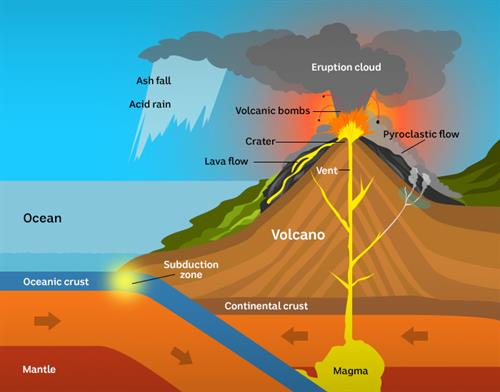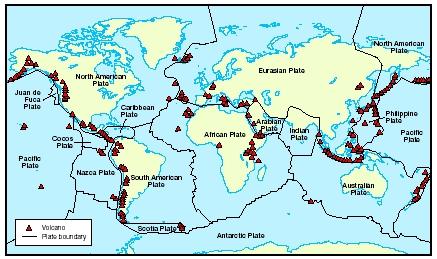PDF chapter test TRY NOW
A volcano is a vent from which a combination of melted rock, solid rock debris and gas erupts. It has a reservoir of molten material below the surface (magma chamber) called magma, and when this magma rises to the surface, it is called lava.

Fig. 9 – Structure of the Volcano
It is well known that the earth’s interior is very hot and as the depth increases from the surface, the temperature too increases and heat rises, ultimately, the heated rock (magma) begins rising slowly toward the surface. The escaping gases provide the driving force for volcanic eruptions, and these volcanic gases are known as steam. Then, this gas-filled magma rises and collects in large pools called magma chambers. As the magma becomes lighter in weight, it rises through channels. When it reaches the surface, it discharges out of vents or openings at the top of the channels. Thus, when the magma (molten rock) discharges out of vents is known as lava. A caldera is a volcanic feature formed by the collapse of a volcano into itself, making it a large, special form of a volcanic crater (Fig. 9).
Causes for Volcanic Eruptions
The main cause for a volcanic eruption is the change in pressure within the volcano, forcing the magma to overflow the chamber it is holding. The eruption caused by the movement of tectonic plates is the most common type. In this kind of eruption, the nature of lava will be sticky and thick with temperatures ranges from 800 to 1,000º\ C.
The other kind of eruption is caused when the tectonic plates move away from each other allowing magma to rise and fill the gap. Here, the lava will be thin with gentle explosion, and the temperature ranges between 800 and 1,200º\ C.
Finally, a decrease in external pressure can trigger an eruption as it minimizes the holding limit of the volcano by increasing the pressures inside the magma chamber.
Nature of Volcanic Eruptions
Volcanic eruptions are classified into two types:
- Fissure Eruption: A slow rise of magma that spreads over a vast area on the surface of the earth. E.g. Deccan Plateau in India and Columbian Plateau in North America.
- Explosive Eruption: It is characterised by lava that is thrown very high into the atmosphere due to the rapid rise of magma. E.g. eruption of Krakatoa on 27^t^h August 1883 in Indonesia.
The lava flow of a volcanic eruption is affected by the viscosity. When the lava is rich in silica and little water, it is highly viscous and flows slowly. Conversely, if it contains less silica and more water, it is less viscous and flows swiftly.
Types of Volcanoes
Three main basic types of volcanoes are:
- Shield Volcano: Several flows of basaltic lava occur in a given region, and they can eventually pile up into the shape of a large mountain called a shield volcano.
- Cinder Cone: The smallest type of volcano with a height of a few hundred meters is known as a cinder cone. Cinder cones primarily consist of gravel-sized pyroclastic.
- Composite Cone (Stratovolcano): The third kind of volcano is a composite cone. Here, the eruptions are sometimes effusive and sometimes explosive. Therefore, composite cones are composed of lava flows and pyroclastic materials.
- Plug Dome: This type is viscous silica-rich magma, pushed up into the vent of a volcanic cone without flowing beyond it. Thus, it forms a plug dome.
On the basis of the periodicity of eruption, volcanoes are divided into three types:
- Active Volcanoes: Constantly ejects lava, gases, ashes and fragmented materials. These types of volcanoes are found along the mid-oceanic ridges representing divergent plate margins and convergent plate margins.
- Dormant Volcanoes: These types of volcanoes become quiet for some period after their eruptions and suddenly erupt again with violence, and cause enormous damage to human health and wealth.
- Extinct Volcanoes: Volcanoes without indications of eruption are considered extinct. Here, the crater is filled up with water and lakes are found.
Distribution of Volcanoes

Fig. 10 – Distribution of Volcanoes
Circum Belt or Pacific Ring of Fire: Most of the high volcanic cones and volcanic mountains are found in this belt, where there is an active subduction of the Pacific, Nazca, Cocos, and juan de fuca plates (Volcanoes of Sumatra and Java, which lies over the subduction zone between the Australian plate and the Eurasian plate).
Mid Atlantic Belt: Volcanoes of fissure eruption type (basaltic type) occur along the mid-oceanic ridge, where seafloor spreading is in progress.
Mid continental Belt: This belt includes volcanoes of the Alpine mountain chains, Mediterranean Sea and those fault zones of Eastern Africa (These volcanoes are caused due to collision of African, Eurasian and Indian plates).
Intra-plate volcanoes: The inner parts of plates are away from the margins. These parts are also called hot spot volcanoes as they occur in the middle of plate boundaries (Volcanoes of Hawaiian Islands).
